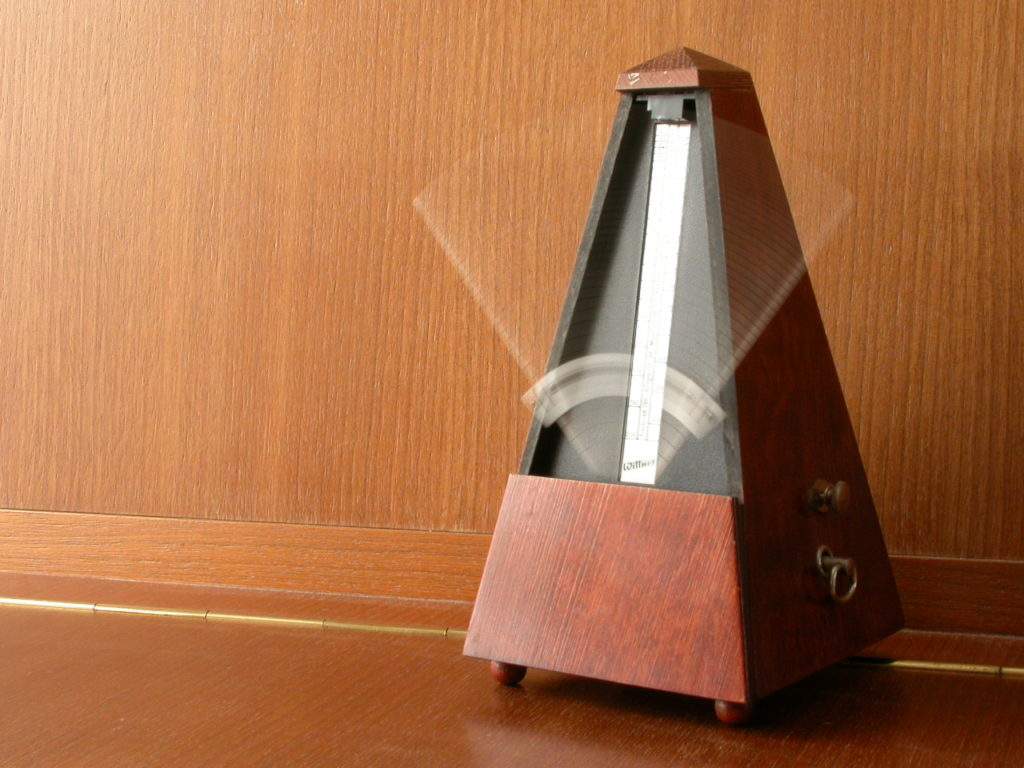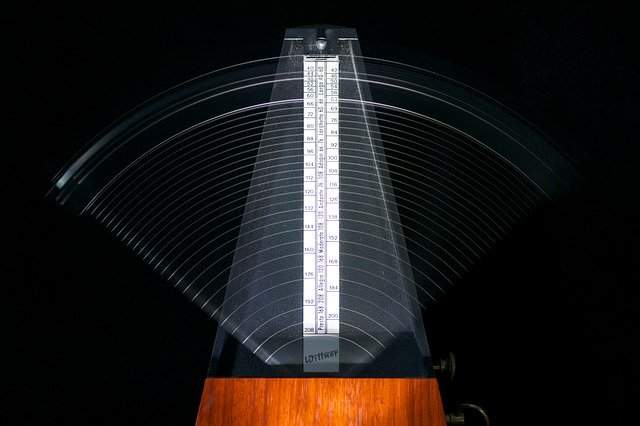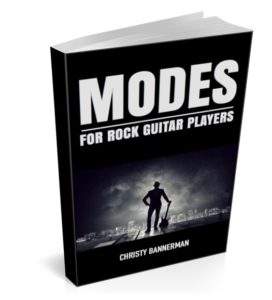Today I want to clarify a common misunderstanding among guitar players who are starting to think seriously about their technique.
This is the widespread belief that “practicing with a metronome” makes you faster, or builds your technique.
Now, virtually every technically-able musician uses a metronome at least some of the time, and nobody denies that the metronome is a useful tool in getting your technique to a high level.
However, the rose-tinted idea many people have of metronome practice strikes me as being a bit like if someone thought that getting a bathroom scale would make them slimmer.
It’s confusing a useful tool you will use on your journey, with the things that actually need to take place to reach the goal.
I’m going explain exactly what I mean, but before we get to that let’s start at the start:
What is a metronome?

A metronome is a simple device which makes an audible click or beep to represent a musical beat at any desired tempo (the musical term for speed).
Metronomes have been used in music practice for almost 200 years, but some people question the need for such a thing in the first place.
Why would you need to have something around that helps keep time?
Because your sense of time isn't as great as you think
People assume that our in-built human sense of timing is pretty good, but in reality it’s changeable and often inaccurate.
To demonstrate this, just consider how drastically your time perception changes depending on what you’re doing, and how you feel about it.
For instance, when you’re having a fun evening with friends an hour can seem to fly by in what feels like only 20 minutes. But if you find yourself listening to an extremely boring presentation on a topic that doesn’t interest you, time seems to grind to a halt and the same 20 minutes can feel more like an hour.
This is also why at live gigs, the songs tend to be played faster than they are on the studio recordings. This is because the musicians are feeling excitement and adrenaline, so their time perception (and therefore their performance) speeds up.
A digital metronome, on the other hand, can tick away for 24 hours straight and it won’t lose a single beat.
This makes it the perfect tool for working on improving your rhythm and timing accuracy.
Practicing with a metronome lets you know when you’re playing things in time (or not), and longer term use encourages you to develop a more accurate internal clock.
Metronomes and technique
As well as working rhythm and timing in general, metronomes can also be used to help you develop your technique.
To see why a metronome is useful in the quest for technical improvement, imagine you practiced something yesterday like a chord change, a scale, sequence or lick, and that you have the goal of making it faster or more fluid to play.
If you’re serious about getting better, then some questions would have to follow:
1) What speed were you doing it at yesterday, or last week?
2) What speed should you resume working on it?
3) Where do you eventually want it to be?
Most importantly:
How do you know if something is actually getting better each time you return to it, or if it just feels different from day-to-day?
If we try to answer any of these using words, we could only describe things in ways like “quick”, “slow”, “gentle”, “extremely quick”, “moderately fast”, etc.
Words like these all mean different things to different people at different times. Playing that’s not particularly fast to me might be seriously fast to one of my intermediate students, for example.
Measuring your progress
The metronome allows you to assign clear numbers to your technical practice, and turns your sense of progress from something vague and intangible into something measurable.
You can know exactly what point you are at with any technical thing you want to improve, and use that information in all sorts of useful ways throughout your practicing.
This is what metronomes do - but nothing more
Now let’s talk about this idea of building speed with the metronome.
There are several ways you can use a metronome to assist in developing your technique, but for now let’s focus on what I would call the ‘classic’ speed-building advice:
How to build speed with a metronome
1) Set the metronome slow enough that you can play the musical item in time to the click (without mistakes - that’s very important), then: 2) Increase the speed by small increments of 4, 2 or even 1 bpm each day, then: 3) Once you can play it without mistakes at the new tempo, increase the metronome again and repeat the process until you reach the desired speed.
Over a given period of time, doing this will steadily increase your guitar speed (so the conventional wisdom goes).
Is this correct? At a basic level and up to a certain point, yes.
It’s the classic advice for a reason – it’s definitely the way to get started, and it’s a solid strategy that you will frequently revisit at various different times.
It also reminds you that the speed gains you make should be good quality, which is always true.
It’s good practice in general, and especially earlier on, and you’ll get some nice results for a while…
Until you hit a ceiling
It’s not that the classic advice is wrong as such. It’s correct for what it is — basic, general advice, something like “speedbuilding 101”:
Start from where you are, build steadily from there, measure what you’re doing…
Those are good basic principles. The issue is that the “using the metronome” part, in and of itself, only takes you so far.
The metronome ceiling
The thing to understand is that there’s nothing magical about playing exercises along to a click.
Most of the benefits you experience when you first start using a metronome are primarily the result of feeling motivated by the information it provides, and of your own natural desire to get things to the next level.
As soon as you see the actual level you’re at with something expressed as a number, there’s a natural drive to improve on your “score” – a bit like if you were playing a game against yourself.
For many people, using a metronome for the first time is also the first time they’ve ever thought about their technique and seen their speed goals in perspective. It’s the first time many people will do any focused deliberate technique practice, and this will of course produce some immediate improvement.
At first you can push it...
The first few times you get stuck at a certain speed, the metronome’s precise increments allow you to increase it by a tiny, almost imperceptible amount each session.
After a few days you can look back and see that your speed with something has gone up by X bpm. This gives your early metronome practice a feeling a momentum because you start seeing some results almost immediately.
Then you think something like this:
“If I just extrapolate how much I progressed in the few days, then within a month or two I’ll be all over that really fast thing I want to crack…”
Right? Ah, if only things were that simple.
... Then you hit it
What you find is that you soon reach a point where the thing you’re working on stops improving and stops getting faster.
When you try to further increase the speed beyond this point, it simply doesn’t happen. You consistently reach an area where things start to break down and you’re unable to play the part cleanly and accurately, no matter how much you try to smooth out the increases in small steps.
It’s like there’s an invisible ceiling or a threshold that you can’t move beyond, and the metronome is no longer helping you to break through it.
Your progress, that you imagined at the start of your odyssey would be an ever-increasing straight line, has slammed into a wall and stopped. This is extremely de-motivating, if you don’t know why it happens or how to solve it.
Progress is not how you imagine
I can tell that many people expect things to go something like this:
“If I’m 10 bpm faster this week than I was last week, then by the end of next week I’m going to be another 10 bpm faster again, and then another 10 by the week after that.”
Only that’s not how it works at all. It’s only like this at the start and for a short time until you hit the ceiling. What then?
Now it’s down to YOU
The ’ceiling’ is not some imaginary idea but a very real thing. You can’t reach out and touch it, but it’s definitely there. What is it you are experiencing at the point where your progress stops?
The ‘ceiling’ is you hitting the current limits of your guitar technique.
You could think of it like a car engine that has a certain power and maximum speed. An engine can’t go faster than its capabilities will allow, no matter how much fuel you give it or how long you accelerate for.
If you really want to go faster, then what you need is to build a bigger engine. This means you need to actively and deliberately make improvements to your guitar technique.
Simply pushing a metronome up a few clicks from where it was yesterday and seeing if you can still hold on for dear life isn’t improving your technique.
Bad technique will never become good technique just because you set it to a metronome.
Without improving your underlying technique, all you’re doing with a metronome is like bending a little piece of metal. At first it starts to bend, then very quickly it starts to get stressed, and when we keeping stretching it beyond this point it just breaks.
This is what’s going on behind the scenes when your ability to play something collapses at a certain speed. Your engine is sputtering out, as your level of technique simply isn’t high enough to play it any faster.
What do you need to do?
You’ve read this far, so what do you think the answer is going to be?
You need to improve your guitar technique and address the problems in there that are holding you back from playing at the level you want to be. What else?
I don’t know what particular problems might be affecting your technique without first having a lesson with you (or at least seeing you play), but what I can tell you is that 99% of technique issues mostly surround 2 main things — tension and efficiency.
Minimise TENSION and Maximise EFFICIENCY
If you listen out, you will hear the most technically accomplished guitarists make reference to these two issues again and again.
That’s a whole other lesson, but the general idea is simple. You need to:
1) Make your movements less tense and ever more relaxed, while
2) Minimising the travel distance and force of your movements.
I can also share some general advice that has always helped me, which is to look at problems in my playing from this perspective:
Why can I NOT do that?
For me it’s not usually a case of “how do I…”, so much as “why can’t I…?
It’s not just a difference of words, but a substantial difference in how you frame everything. You need to become like your own guitar doctor – accurately diagnosing symptoms and curing their underlying causes.
That’s what I do.
A good teacher can help you achieve this so much faster than on your own, but this is what you need to do. You need to develop a problem-solving and solution-focused mentality with every technical issue you encounter.
Imagine an ideal version of yourself with the exact level of guitar technique you want. Where there is almost no barrier between you and the guitar, and anything you want to you can play with ease, no matter how physically challenging.
There are many guitarists who demonstrate great technique, and my advice is to find out who they are and take note. Whether or not you like them as musicians, I really think you should at least be able to recognise when a guitarist has excellent physical technique if you want to be a good player yourself.
My approach to technique has always been to work backwards from the ideal, and work out what’s in my way. Then I kick down these obstacles by thinking through the underlying problem and taking the necessary steps to fix it.
Mindless practice
My approach, and that of most professional players with advanced technique, contrasts sharply with how I see many students use a metronome.
You can’t approach your technique practice as if the metronome is some kind of magic device that will grant you speed just by using it, because it won’t.
Some of my biggest technical gains came about when the metronome wasn’t even switched on, and I was really thinking about and observing what was going on in my physical motions at a deep level.
I have also had enormous technical breakthroughs while using the metronome, breakthroughs that wouldn’t have been possible otherwise.
However, even at these times, it wasn’t a metronome that made me faster. It was me.
You make yourself faster, by addressing the problems holding you back, and then by training in new, better habits until you get it right.
Anyone can switch on a metronome and increase it by a single bpm, but you won’t develop good guitar technique or gain any serious, reliable speed if you do what many people do, which I call “mindless practice”.
Mindless practice is when you treat practice a bit like a thoughtless chore that you just have to get through.
It’s when you turn up, punch in and look busy, but you aren’t engaging your your mind and your senses on the task with the required effort and care.
It’s when there’s no passion, focus, or hunger for improvement – you’re just going through the motions, literally.
Mindless practice will get you nowhere. Thoughtless, careless repetition isn’t even ‘practice’ by any musician’s standards, and it certainly won’t make you any faster or play any better.
If you want to build a great technique and be able to play fast then go for it — you can absolutely do it, and a metronome will be indispensably useful in your quest.
But never forget that it’s only YOU who can make yourself a better player, not that little beeping box!
– Christy
Download a free Metronome
For an excellent (and 100% free, without ads) metronome app on your smartphone I recommend checking out Soundbrenner:





